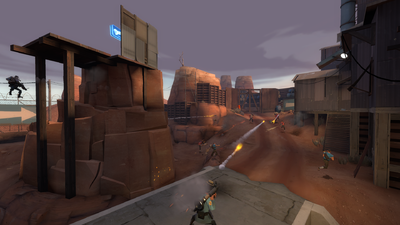Community competitive play
| “You are so small! Is funny to me!” This article is a stub. As such, it is not complete. You can help Team Fortress Wiki by expanding it. |

| “ | Major League!
Click to listen
— The Scout
|
” |
Competitive play refers to organized gaming done for the purpose of having fun through skillful competition, practiced teamwork, and self-improvement, especially in a league setting.
Contents
Format
- See also: Standard competitive format
All competitive games are based round the following principles:
- Team members are chosen before the game starts.
- Players use vocal communication to quickly relay information.
- Both teams are of the same predetermined player count.
Beyond these, there are many differences between various leagues, seasons, and communities. That said, most competitive TF2 games follow the standard competitive format, which has class limits, 6 players per team, and certain gameplay settings that try to encourage fairness and reduce the impact of chance. All of the major TF2 leagues and Template:W communities follow the standard competitive format, though each has variations on specific rules. Some smaller leagues run more specialized formats, such as Highlander, where each team always uses one of each class.
The most popular competitive is six versus six. Which as the name suggests is about two teams of six players fighting to capture the most points. In America it's the first team to capture five points will automatically win, there's also a color change after the third round; whereas in Europe it's the first team to get a point difference of five or more points in 30 minutes.
The competitive scene favors 5CP maps such as Badlands and Granary. Non-official maps are used as well, such as Snakewater. Other map formats such as Attack/Defense and Capture-the-Flag are used occasionally; maps such as Gravelpit and Turbine respectively are used.
Dynamics
- See also: Category:Competitive
Patterns and protocols have emerged from competitive play's unique format and setting, leading to a set of gameplay dynamics distinct from non-competitive play.
- Certain dynamics have become a standard in competitive play, one of the most noticeable is roll-outs, you don't tend to find them being used in public games. The basic idea of a roll-out is to get to mid quicker by rocket and sticky jumping. By trading health you are trying to get there quicker to get a better position and lock the other team out of the point.
- ÜberCharges are what competitive Team Fortress 2 is all about, Medics on both teams have to track both their ÜberCharge, and the enemy Medics as best they can. This is because when a team doesn't have an ÜberCharge they are vulnerable to pushes against a team that does as they can't save any team mates who are at low health.
- The team is split into to smaller forces, the combo and the flanks. The combo consists of the Medic, Soldier and Demoman, whilst the flanks consist of the Scouts and the roamer who hovers in between the flanks and the combo.
Classes
- See also: Standard competitive lineup and Category:Classes (competitive)
Classes are used somewhat differently in standard competitive play than they are in public play. The smaller team sizes, increased coordination, class limits, and refraining from turtle-prone maps result in classes being used at different times, for different reasons, and for different durations than one might except in a typical public TF2 game. The usual, or standard setup for competitive teams (commonly referred to as the "Cookie Cutter" setup) is often two Soldiers, one Demoman, two Scouts, and one Medic. Any other class is referred to as a utility class. Due to the different style of game play, there is a competitive version of each class article:
| Scout |
Soldier |
Pyro |
Demoman |
Heavy |
Engineer |
Medic |
Sniper |
Spy |
Weapon restrictions
Within some competitive leagues, restrictions on items allowed in matches are employed to ensure matches are balanced. See Competitive item restrictions for a list of restricted items in certain leagues.
Maps
The majority of competitive play is done on 5-cp push maps, though exceptions sometimes exist (most notably Gravel Pit, Turbine, and Viaduct). On these maps, the standard format and lineup have caused strategies and tactics to form unique to competitive TF2. You can read more about them in each map's competitive article:
- Badlands (competitive)
- Fastlane (competitive)
- Prolane (competitive)
- Follower (competitive)
- Freight (competitive)
- Granary (competitive)
- Gravel Pit (competitive)
- Gullywash (competitive)
- Obscure (competitive)
- Turbine (competitive)
- Turbine_pro (competitive)
- Viaduct (competitive)
- Waste (competitive)
- Well (competitive)
- Yukon (competitive)
- Coldfront (competitive)
- Warmfront (competitive)
- Snakewater (competitive)
- Bazillion (competitive)
- pro_Viaduct (competitive)
- Obscure_remake (competitive)
- metalworks (competitive)
Organizations
European Or Global
North American
- ESEA's TF2 Invitational and TF2 Open Divisions
- TWL's TF2 League
- UGC
- CEVO's TF2 6v6 league.
European
Asian
Oceanian
Country specific
Each of these leagues mainly run the standard competitive format, however some host Highlander, 7v7 and 1v1 competitions.
CommFT and VanillaTF2 are fairly well-known portals that post current events for the competitive TF2 scenes in North America and Europe respectively. Another popular place for North American competitive TF2 discussion and demo sharing is GotFrag.
Additional Reading
- If you're interested in the competitive league and you don't know where to start, guides can be found here and here.
| |||||||||||||||||||||||||||||||